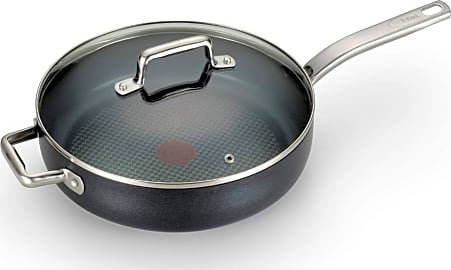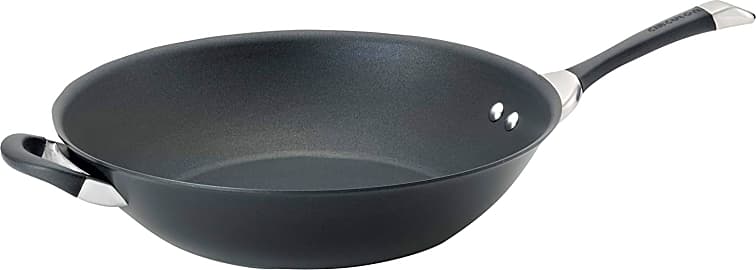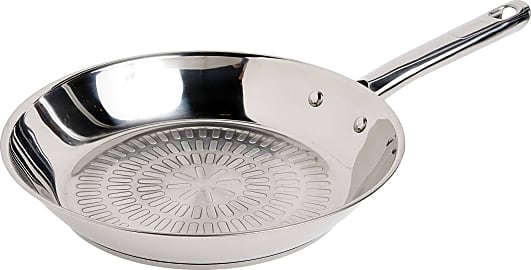The 7 Best Frying Pans

This wiki has been updated 40 times since it was first published in May of 2015. If you’re like most home cooks, you probably use a frying pan on a daily basis for preparing foods like eggs, pancakes, grilled cheese, chicken, fish, and more. They come in a variety of materials including durable cast iron, oven-proof stainless steel, lightweight aluminum, and evenly heating copper. Here we rank them based on factors like performance, durability, ease of use, and price. When users buy our independently chosen editorial choices, we may earn commissions to help fund the Wiki.
Editor's Notes
April 09, 2021:
There are a few things that the term "frying pan" can refer to it. You've got your pro-level saute pans like the nonstick Tramontina Professional and Matfer Bourgeat Carbon Steel, and on the other side of the spectrum sit large-batch options like the T-fal C51782.
Between those two extremes, though, there are tons of great pans to cook with. The T-fal E93897 offers steep, sloping sides balanced with a mid-range weight and above-average nonstick surface, so it's really great for just about any type of food. The Circulon Symmetry is similarly constructed, but has tall sides much like those of a wok. Finally, if you're looking for something extra-fancy, you can't go wrong with the iconic All-Clad 4110.
March 18, 2020:
Today we added the All-Clad 4114 to this selection, which is from the manufacturer’s popular line of stainless steel cookware. It features bonded three-ply construction: an aluminum core sandwiched between stainless steel exterior and interior layers. The aluminum core distributes heat well throughout its surface. This is a model that’s durable and well suited for cooks of all skill sets. Its interior is highly polished and includes a starburst finish to help keep foods from sticking and make it easy to clean.
The DaTerra Cucina Vesuvio is a premium model that’s as attractive as it is functional. It’s made with a nonstick surface that doesn’t contain potentially harmful chemicals. The glass lid features a tight silicone seal. It’s artisan-made in Italy and carries a 365-day money-back guarantee. If you’ve got your heart set on cast iron, look no further than the Lodge Cast-Iron L10. Unlike the DaTerra, this one is conveniently preseasoned, so it’s ready for use right when you receive it. It’s great for use on stovetops and campfires, as well as in the oven.
Leaving the list today is the Utopia Kitchen Jumbo, which is unavailable at this time. Note that frying pans are usually included in entire cookware sets. If you’re moving into your first home or all your pots and pans are simply in need of replacing, check out or lists of best cookware sets as well as best budget cookware sets.
Special Honors
Williams Sonoma Thermo-Clad Copper Fry Pan Created by coppersmiths at Ruffoni, this pan is part of a series of pieces that combine mirror-finish copper with elements of practical stainless steel. The result is high heat responsiveness, which gives you a lot of control when you’re frying, browning, and sautéing. It’s available in 10- and 12-inch diameter sizes, and is oven safe to 450 degrees Fahrenheit. It’s handcrafted in Italy and is sold with or without a helper handle on the side opposite the main one. williams-sonoma.com
What Do I Need To Consider Before Purchasing A Frying Pan?
Depending on how you plan on using a frying pan, you may want to take note of its oven-safe temperature.
You might be surprised to discover that all frying pans are not created equal. Far from it, in fact. You can start with a pan's handle, which may be made of coated plastic, wood, or some other substance that will not scorch your hands. There are certain pans on the market, however, that are built as one cohesive unit, meaning that if you grab the metal handle without a potholder or an oven mitt, there's a decent chance you will get burned.
An average frying pan can weigh anywhere between 2-12 lbs, which is significant, especially for anyone who enjoys cooking dishes that require tossing the ingredients to achieve a proper flavor. A pan's weight is usually the result of whatever that pan is made of, and how thick the metal has been molded. Cast-iron pans are extremely durable, for example, but they may also be unwieldy. An aluminum pan may be easier to manipulate, and yet its surface may also be a bit more prone to wear.
Whenever shopping for a frying pan, you'll want to look for phrases like scratch-resistant, and no-stick surface, as these are reliable indications that any cooked food will slide onto a plate easily, and the pan's surface won't be difficult to scrub. Along those lines, it's also worth confirming whether a pan is dishwasher-safe, as this might save you some time and elbow grease.
Depending on how you plan on using a frying pan, you may want to take note of its oven-safe temperature. Oven-safe temperature refers to how much heat a frying pan can withstand inside an oven before it becomes susceptible to damage. Of course, the majority of fried foods are meant to be heated over a burner, but in the event that a certain recipe calls for placing a pan inside the oven, it's worth pursuing a model that is oven-safe up to a temperature of 450 degrees or higher.
Frying 101: Several Basic Tips
Frying is a great way to prepare foods so that they're brimming with flavor. At the same time, any successful pan-fry begins long before you place the food into a skillet. Different meats might benefit from marinating, for example. And marinating may require a bit of prep work several hours, or even an entire day, before the cooking actually begins.
At the same time, any successful pan-fry begins long before you place the food into a skillet.
If you're frying meat, it's best to remove that meat from the freezer early so that it has ample time to defrost. Prior to cooking the meat, be sure to pat it down with a paper towel, drying off any spare beads of moisture. Mixing moisture with cooking oil in a preheated pan will cause the oil to hiss, putting you at risk for a burn. Moist meat may cook up soggy, as well.
Assuming you are cooking meat in an oily batter, you'll want to roll the meat in flour to ensure that the batter sticks. Otherwise, your food may end up with patches of batter, resulting in an uneven texture that could affect the taste.
Every blend of cooking oil has what is known as a smoke point - the temperature at which that oil gets hot enough to sear, or cook, something. Canola oil, for example, has an extremely high smoke point of 205 degrees. Alternative choices like sunflower oil, peanut oil, and safflower oil have lower smoke points. The bottom line being that if your fried foods come out tasting bland or overdone, it may be the oil, as opposed to the recipe or any other ingredients, that is to blame.
How The Frying Pan Has Evolved Via Different Cultures
The earliest known frying pans existed in Ancient Mesopotamia, and these pans were little more than flat earthenware sheets that could be warmed with oil over a fire. The Ancient Greeks improved upon this idea by introducing a metal pan known as a tagenon. A tagenon was usually accompanied by a cone-shaped lid with a pull handle on the top. The pan itself would be used as a plate after the cooking was complete.
The earliest known frying pans existed in Ancient Mesopotamia, and these pans were little more than flat earthenware sheets that could be warmed with oil over a fire.
During the 2nd century, the Ancient Romans handcrafted a frying pan known as a patella, which was made of copper or bronze. A patella featured high-curving walls around the edges so that food could be manipulated by a fork or a spatula, and oil could be drained without solid ingredients spilling over. In Roman mythology, Patella was an agricultural goddess who ripened crops, giving life to the annual harvests.
Toward the end of the Middle Ages, certain European cultures used a cast-iron bowl with three metal legs known as a spider pan to fry their food. The spider pan was different than its predecessors in that it didn't need to be held or suspended over a flame. Spider pans were unwieldy, but they could be set down on a table by their metal legs and used as a serving dish after a meal had been prepared.
After metal stoves were invented during the 18th century, the French invented several variations on the traditional frying pan, including the sauteuse (a saute pan), the evasee (a specialized pan with sloping edges), and the fait-tout (an all-purpose pan that's name literally means "to do everything").
The first company to patent and produce an electric frying pan was Sunbeam in 1953. The Automatic Frying Pan, as it came to be known, allowed American consumers to cook fried foods without any need for a burner or a stove.












